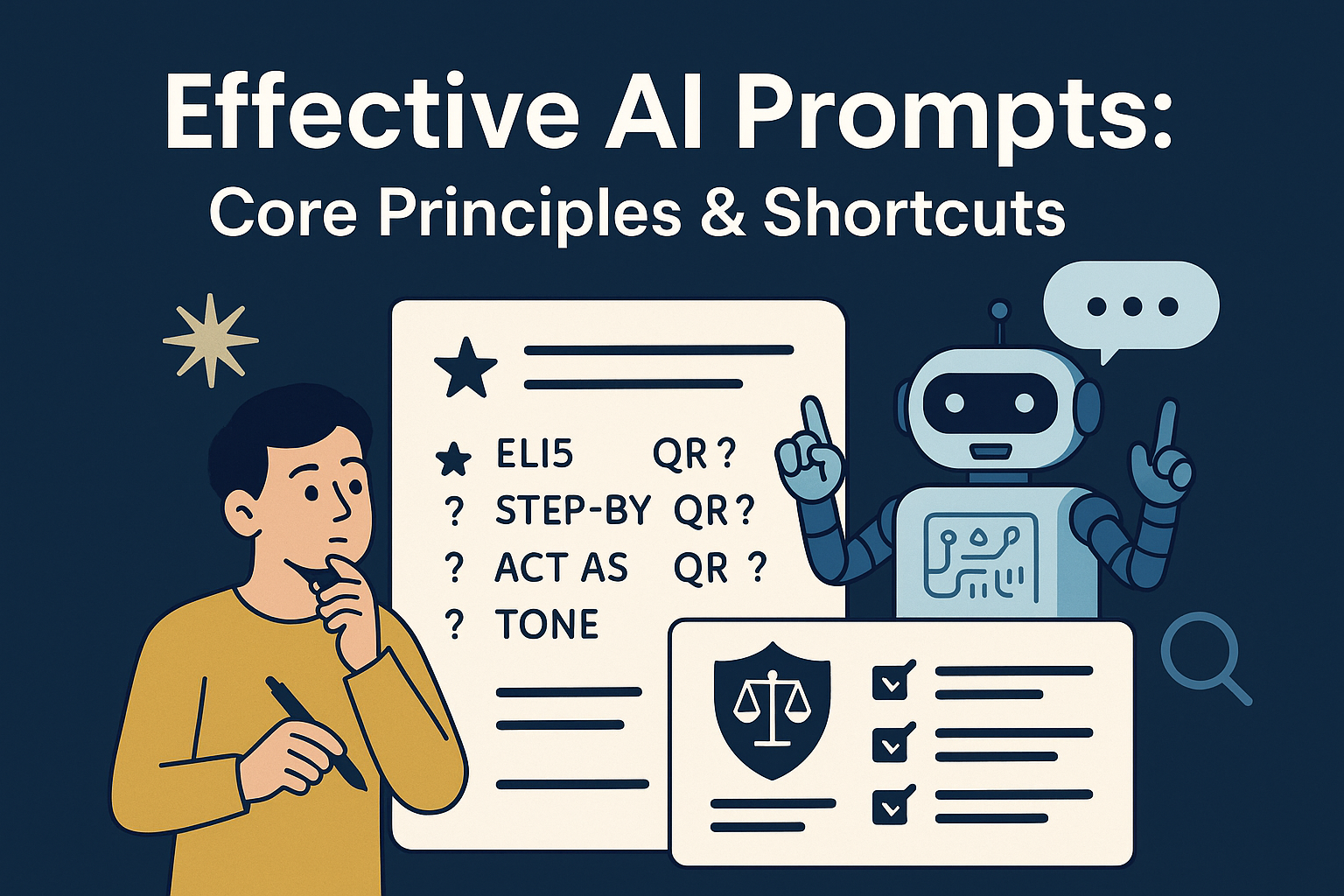
In the rapidly evolving landscape of Artificial Intelligence, the ability to communicate effectively with large language models (LLMs) is becoming an essential skill. This document outlines core principles and practical shortcuts for crafting effective prompts, enabling you to unlock the full potential of AI and achieve more precise, relevant, and high-quality outputs.
Understanding and applying these prompting techniques can significantly enhance your interaction with AI, transforming it from a simple query tool into a powerful strategic partner. By intentionally designing your prompts, you can guide the AI to think more deeply, structure its responses logically, adopt specific personas, and tailor information to diverse audiences. This leads to increased efficiency, better decision-making, and a higher return on your investment in AI tools.
✨ Core Prompting Principles
Effective prompting is less about finding a “magic word” and more about clear, structured communication. Think of it as delegating a task to a highly intelligent, but literal, assistant.
- Be Direct Tell the AI exactly what you want in plain, unambiguous language. Avoid vague requests. The more clarity you provide, the better the AI can understand and fulfill your intent. Think of it as delegating to a smart intern: more clarity = better results.
- Structure Matters Organize your prompt with clear formatting. Use headers, bullet points, numbered steps, or distinct paragraphs to separate different instructions or pieces of context. The model often mirrors the structure you provide, leading to more organized and readable outputs.
- Think Roles + Tasks Assigning a role to the AI helps shape its tone, expertise, and focus. Phrases like “Act as…” or “You are a…” can dramatically influence the perspective and style of the response.
- Examples:
- “Act as a cybersecurity consultant.”
- “You’re a product manager preparing a competitive brief.”
- Examples:
- Default Output = Default Thinking If you don’t explicitly ask for specific structure, depth, tone, or a particular line of reasoning, you’ll likely receive average, generic responses. To get exceptional results, you must push the AI further by specifying your requirements.
🔍 Prompting Shortcuts That Work
These phrases and techniques act as powerful directives, activating specific behaviors and modes of thinking within the AI model.
✅ General Utility
- ELI5 – “Explain it like I’m five years old.” Use this for simplification of complex topics.
- TL;DR / EXEC SUMMARY – Instructs the AI to summarize the most important points concisely.
- STEP-BY-STEP – Ask it to walk through reasoning or a process in a logical, sequential order.
- CHECKLIST – Request the output to be structured as actionable bullet points or a list of items to verify.
- COMPARE – Prompt the AI to list pros/cons, similarities, or differences across multiple options or concepts.
- FORMAT AS [table/list/etc.] – Explicitly define the desired output format (e.g., “Format as a Markdown table,” “Format as a JSON object,” “Format as a bulleted list”).
- ACT AS – Define a specific role or persona for the AI to adopt: lawyer, teacher, analyst, marketer, etc.
💡 Clarity & Audience Control
- JARGON: Use phrases like “Avoid jargon” or “Use technical terms appropriately” to control the complexity of the language.
- AUDIENCE: Specify the target audience for the response (e.g., “Write this for a CFO,” “Explain to a junior engineer,” “Tailor for a general audience”).
- TONE: Dictate the emotional or stylistic quality of the writing: Formal, casual, persuasive, cautious, enthusiastic, empathetic, academic, humorous, etc.
⚖️ Reasoning & Critical Thinking
- CHAIN OF THOUGHT / STEP-BY-STEP – Encourage the AI to show its logical progression, breaking down a problem and solving it one step at a time. This often leads to more accurate and verifiable results.
- FIRST PRINCIPLES – Ask the AI to break down a problem to its fundamental truths and rebuild a solution from scratch, avoiding assumptions.
- REFLECTIVE MODE / EVAL-SELF – Instruct the AI to critically evaluate its own previous response, identify potential weaknesses, or suggest improvements.
- SOCRATIC MODE – Guide the AI to respond by asking clarifying questions rather than providing direct answers, fostering deeper exploration of a topic.
- PRE-MORTEM – “Assume this fails. What went wrong?” This technique encourages the AI to identify potential risks and failure points proactively.
- MULTI-PERSPECTIVE – Ask the AI to present a topic from several different viewpoints or stakeholder perspectives.
⚡ Specialized Prompts for Strategy & Development
- SWOT – Strengths, Weaknesses, Opportunities, Threats analysis. A classic strategic planning tool.
- CONTEXT STACK – Provide a history of previous decisions or events and then ask for the next logical steps or recommendations based on that context.
- IF/THEN INTERACTIVE – Add conditional statements to explore different scenarios or outcomes based on varying inputs.
- DRAFT | REVIEW | PUBLISH – Ask the AI to iterate through a multi-stage process, mimicking a real-world workflow (e.g., “First, draft the email. Then, review it for clarity. Finally, prepare it for publication.”).
- PRIORITIZE: Ask it to rank outcomes, action steps, or criteria based on specified factors (e.g., “Prioritize these tasks by impact and effort”).
- CONSTRAINT MODE: Impose specific limitations on the output (e.g., “Do this in under 100 words,” “No more than 3 bullet points,” “Use only positive language”).
🧠 Speculative or Symbolic Prompts (Fun but Not Functional)
These phrases are often used to set a creative mindset or add flavor to a prompt, but they don’t unlock hidden features or “modes” within the AI model itself. Their effectiveness comes from how they influence the user’s phrasing and, by extension, the AI’s interpretation of the desired output.
- THOUGHT_WIPE – (Imagine clearing mental context) – A way to ask for a fresh start, free from previous conversational bias.
- GHOST_INJECT – (Inject external perspective) – A creative way to ask for an outside, unbiased viewpoint.
- SHADOW_PRO – (Imagine expert mode, deeper reasoning) – An informal way to request a more advanced or nuanced analysis.
- NO AUTOPILOT – Tell the AI not to assume anything, recheck logic – Emphasizes the need for thorough, independent verification.
- ZERO IMPRINT – Request bias-free, neutral thinking – A strong directive for objective and impartial responses.
These don’t “trigger” real modes in the model but can simulate a mindset if phrased creatively, encouraging the AI to adhere more strictly to principles like objectivity or independent reasoning.
🏛 Template Example
Combining these principles and shortcuts allows for highly effective prompts.
Prompt:
Act as a risk management consultant.
Summarize the attached policy in checklist format.
Then evaluate its weaknesses using a SWOT analysis.
Avoid legal jargon. Use formal tone for executive review.
Why It Works:
- Defines a role: “Act as a risk management consultant.” – Sets the persona and expertise.
- Specifies structure: “Summarize… in checklist format.” and “evaluate… using a SWOT analysis.” – Dictates the output organization.
- Controls tone: “Use formal tone for executive review.” – Ensures appropriate language for the audience.
- Sets clear tasks: “Summarize…” and “evaluate…” – Provides explicit instructions for the AI to follow.
- Adds constraints: “Avoid legal jargon.” – Guides the language choice.
📊 Prompting Success = Intentional Design
If you’re not getting the desired answers from an AI, the limitation is rarely the AI itself, but rather the prompt. Instead of assuming the AI is limited, assume the prompt needs tuning. Try:
- Rephrasing the question: Sometimes a slight change in wording can make a big difference.
- Adding step-by-step instructions: Break down complex requests into smaller, manageable parts.
- Asking it to critique its first draft: Engage the AI in an iterative process to refine its own output.
Train yourself to talk to AI like a strategic teammate, providing clear instructions, context, and expectations, rather than treating it like a magic box that inherently knows your unspoken desires.


